Razer’s Upgrades Blade 15 For 2019: OLED 4K or 240 Hz Displays, New CPUs & GeForce RTX
by Anton Shilov on April 23, 2019 12:00 PM EST- Posted in
- Laptops
- Intel
- Razer
- Blade
- Core 9th Gen
- GeForce RTX
- Blade 15
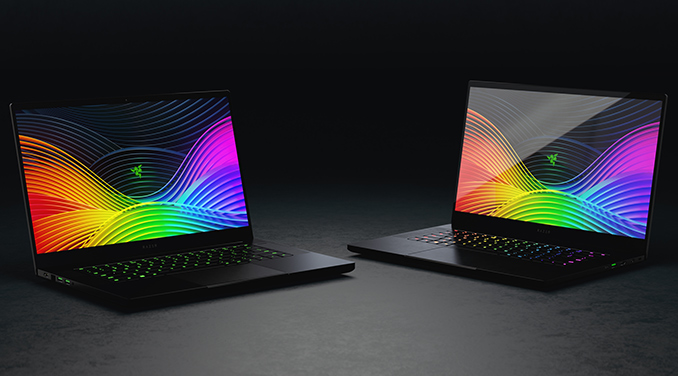
Kicking off a torrent of new laptops hitting the streets today, Razer has introduced its next generation Blade 15 laptops for gamers and prosumers. One of the core laptops within Razer's product portfolio, the new Blade 15 offers OLED or 240 Hz LCD display options, Intel’s latest six-core CPU, and NVIDIA’s GeForce RTX graphics processors. The new gaming notebooks will clearly offer considerably better user experience than their predecessors due to improvements, but they will also be slightly bulkier than the Blade 15 machines launched last year.
So Similar, Yet So Different
Having established a strong position in the market for gaming laptops, Razer is now expanding its families to address the needs of wider user bases. This year Razer will offer one Blade 15 Base model designed for mainstream gamers, as well as multiple versions of its Blade 15 Advanced models aimed at more demanding customers and prosumers. While the new Blade 15 SKUs have similarities, these are very different notebooks at times.
All of the various 2019 Blade 15 models are powered by Intel’s six-core Core i7-9750H processor (2.6 – 4.5 GHz) as well as HM370 chipset. And both chassis designs are made of CNC-machined aluminum chassis (with ‘advanced’ models available both in black and silver) that have been outfitted with a 15.6-inch display. Overall the base model Blade 15 is 19.9 mm thick, whereas the Blade 15 Advanced is 17.8 mm thick, the shrink owing to the differences in the systems that go right on down to the change in motherboards motherboards.
The Blade 15 Base
The Razer 15 Base model is equipped with a 15.6-inch Full-HD matte display featuring a 144 Hz refresh rate, NVIDIA’s GeForce RTX 2060 GPU with 6 GB of GDDR4 memory, 16 GB of DDR4-2667 RAM (expandable to 32 GB), and a 512 GB PCIe 3.0 x4/NVMe SSD. The laptop has an empty 2.5-inch SATA bay, allowing an additional SATA HDD/SSD to be installed to expand storage space.
Being aimed at mainstream gamers, the Razer 15 Base is configured rather conservatively when it comes to connectivity and general I/O features. The notebook has Intel’s Wireless-AC 9560 802.11ac + Bluetooth 5 solution, a GbE port, one Thunderbolt 3 connector, three USB 3.1 Gen 1 Type-A ports, two display outputs (miniDP 1.4 and HDMI 2.0b), a 3.5-mm headset jack, a 1MP/720p webcam, and so on.
Since the notebook has a 2.5-inch bay that takes up a bit of room, the Razer 15 Base comes with a slightly smaller 65 Wh lithium-ion polymer battery. With that battery installed, the laptop weighs 2.1 kilograms, which is pretty light for a 15.6-inch mobile PC
The Blade 15 Advanced
The Advanced version of the Blade 15 is aimed not only at hardcore gamers that will enjoy a 15.6-inch LCD with a 240 Hz refresh rate, but also on prosumers who will take advantage of a 4K Ultra-HD OLED touch-sensitive monitor featuring a 1 ms response time and a 100% coverage of the P3 D65 (Razer says DCI-P3 but it is likely P3 D65) color gamut.
To provide better performance in games, Razer’s Blade 15 Advanced notebooks come with either NVIDIA’s GeForce RTX 2070 8 GB Max-Q or GeForce RTX 2080 8 GB Max-Q. The laptops are equipped with 16 GB of DDR4-2667 (expandable to 64 GB) of RAM as well as a 256 GB or 512 GB PCIe 3.0 x4/NVMe SSD. It is noteworthy that the ‘advanced’ notebooks do not have the base model's 2.5-inch SATA bay for further storage expansion.
Since the Blade 15 Advanced SKUs are designed for power users that tend to be less conservative yet more demanding than mainstream gamers, the PCs deprecate GbE, but are outfitted with Intel’s Wireless-AX200 802.11ax + Bluetooth 5 solution, one Thunderbolt 3 connector, three USB 3.2 Gen 2 Type-A ports, two display outputs (mDP 1.4 and HDMI 2.0b), a 3.5mm audio jack, a 1MP/720p webcam with IR sensors for Windows Hello, and so on.
The lack of a a 2.5-inch bay also means that Razer could install a larger 80 Wh battery inside. The larger battery does add ever the slightest amount of weight compared to the base model, with the weight of the advanced models ranging between 2.15 and 2.21 kilograms. However what these models add in weight they lose in overall thickness, with a z-height of just 17.8 mm.
Pricing & Availability
Razer’s new Blade 15 gaming laptops will be available directly from the company in North America starting this week, with broader availability expected in May. The Blade 15 Base model will be priced at $1,999, whereas the Blade 15 Advanced will start at $2,399.
Related Reading:
- Razer Launches The Razer Blade 15.6
- Razer Reveals New Blade Pro: GTX 1060 Graphics, Full HD, Lower Price Point
- Razer Updates The Razer Blade Pro With THX Certification
Source: Razer



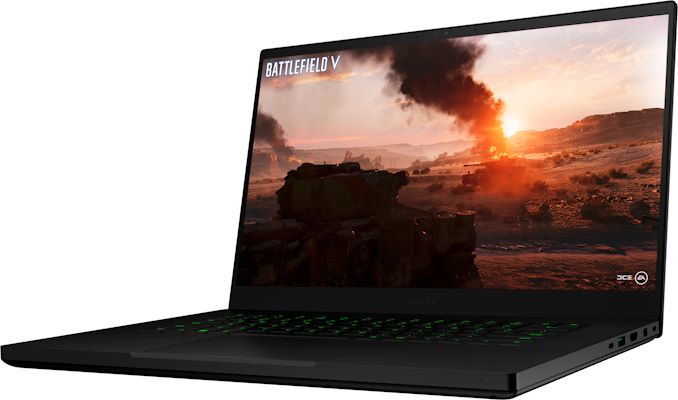
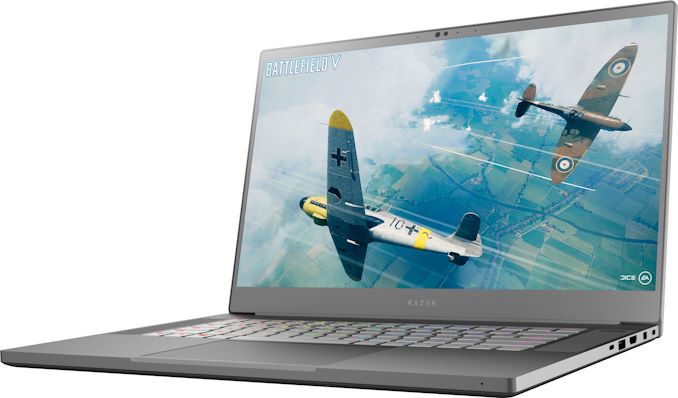
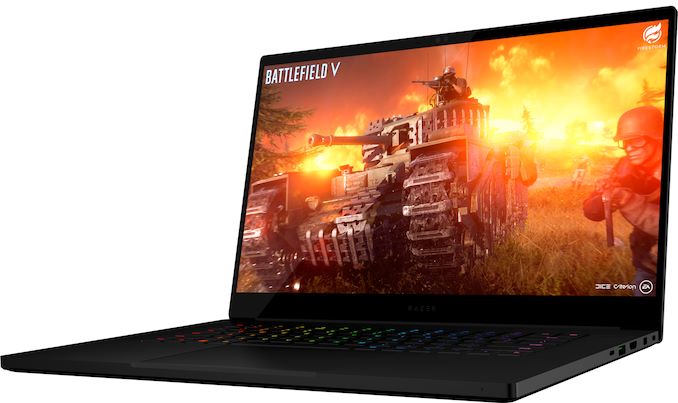
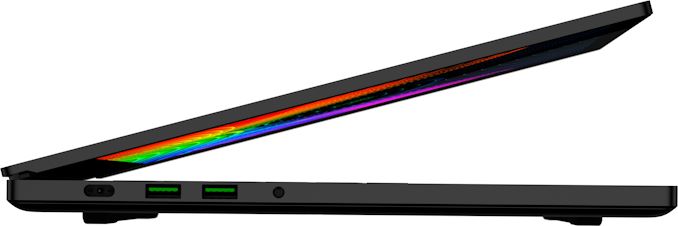
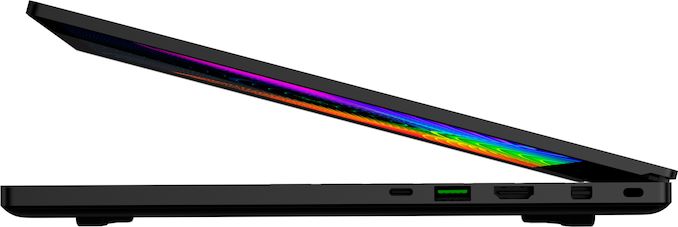
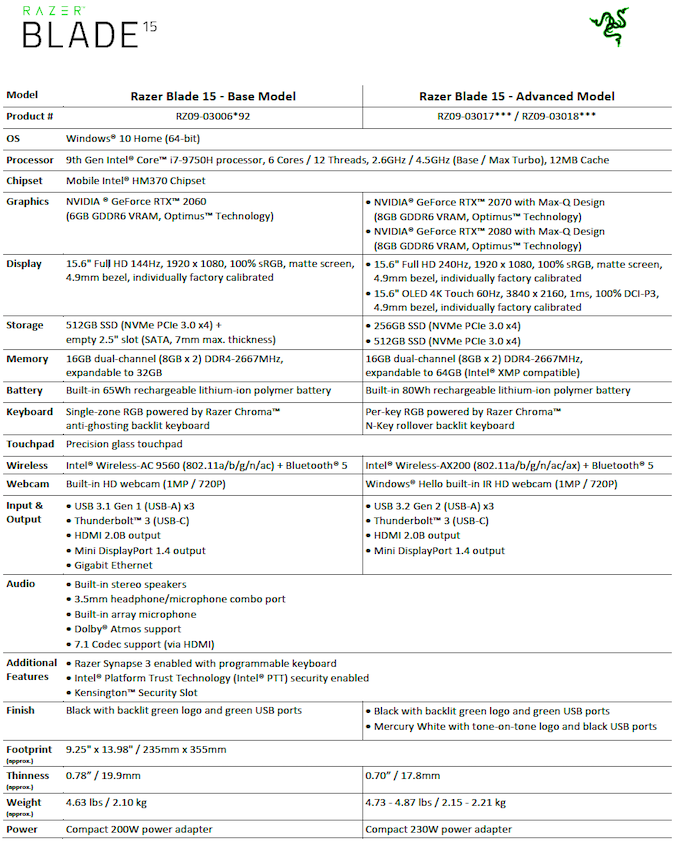








31 Comments
View All Comments
Valantar - Tuesday, April 23, 2019 - link
240Hz, but no G-Sync? That sounds ... juddery. Unless all you're doing is playing esports games, that is, or _love_ to adjust your refresh rate every time you start a new game.willis936 - Tuesday, April 23, 2019 - link
Juddery? areYouSureAboutThatJohnCena.aviAlso lower your settings., g-sync is an implementation, it doesn't change the rules and limitations. It is maybe 15% better for smoother frame rates when the frame rate is already way, way too low while adding 15% more latency.
KateH - Wednesday, April 24, 2019 - link
"Juddery"i caught that too...
I think i'd take *stuttery* gameplay over my computer suddenly violently shaking midgame ;-)
TheWereCat - Wednesday, April 24, 2019 - link
GSync/FreeSync don't add latency, the higher latency is a result of lower frame rate.And Valantar is right. There's no way that a laptop CPU can handle 240Hz games without massive swings in FPS. GSync/FreeSync is a must
willis936 - Wednesday, April 24, 2019 - link
Adaptive refresh rate technologies add about as much latency as proper triple buffering (0-1 frame). Vsync off will always be the lowest latency option.If you can’t drive 240 fps you should still be driving 100+ fps. Seeing frame rate fluctuations above 100 fps is hardly an issue compared to frame rate fluctuations below 60 fps. Adaptive refresh rates technology were invented to polish turds because that’s where they shine. At the end of the day if you have infinite fps all of these solutions are equivalent, so why not just turn down your settings and get higher frame rates and lower input latency if you care about it?
TheWereCat - Wednesday, April 24, 2019 - link
How do you measure latency in frames by saying "0-1 frame"? 1 frame at 60Hz is 16.66ms which has way more different meaning than 1 frame at 240Hz which is 4.16ms.Thats why I said that the latency is result of the frame rate since the latency will change based on what refresh rate the GSync or FreeSync will change to on a moments notice.
You would have to have a perfect frame rate capped at X with no fluctuations at all and test with and without GSync or FreeSync to be able to even measure it which is very difficult at high frame rates so the tests usually become very flawed above 60FPS.
And you cant just lower settings to get better performance if you aim for 240Hz gaming. You need CPU power to push the frames, not just GPU. And you are 100% capped by CPU in all laptops that exist since they cant boost high enough either due to clock and thermal constraints or power limit. This is assuming you have infinite GPU power, your FPS will still swing like hell because of the CPU.
Sure, you may be able to play few of the eSports titles just fine but not all of them.
willis936 - Wednesday, April 24, 2019 - link
I said the latency was 0-1 frames because that is what it is. Frame times are shorter with higher refresh rates. What is the part that you are contesting? On average you will get lower input latency with vsync off. Input latency fluctuations become less important with shorter frame times. If you can't drive < 60 fps then you should cap the frame rate. Adaptive refresh rates won't solve that problem.The main point I'm making is that adaptive refresh rate technologies aren't the end all solution and tbh a higher refresh rate panel is a better solution to the same sets of problems that a panel with an adaptive refresh rate would solve.
Brett Howse - Wednesday, April 24, 2019 - link
Blade uses Optimus which you can't have with G-SYNC unfortunately.KateH - Wednesday, April 24, 2019 - link
speaking as someone who basically has to do this (HDMI Freesync monitor + Geforce... yes i knew what i was getting into when purchased) setting refresh rates for each game isn't so bad. It's just another setting to change when dialing in the optimal config for a newly-installed game. And then the game remembers just like any other setting and that's it.At least we get to adjust refresh rates again! I grew up gaming on CRTs getting to be choosy about refresh rates, only to spend the past decade-and-a-half being stuck on 60hz LCDs with little options other than overclocking or $$$ panels.
oRAirwolf - Wednesday, April 24, 2019 - link
My XPS 15 was stolen recently and I have been waiting for the new OLED version to come out before buying a new one. This Razer might be a suitable replacement. I'm just not sure about Razer's reliability based off my anecdotal personal experience with Razer mice and LTT's RMA track record with their laptops.